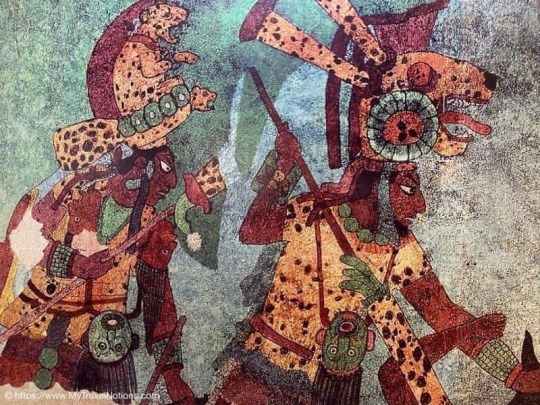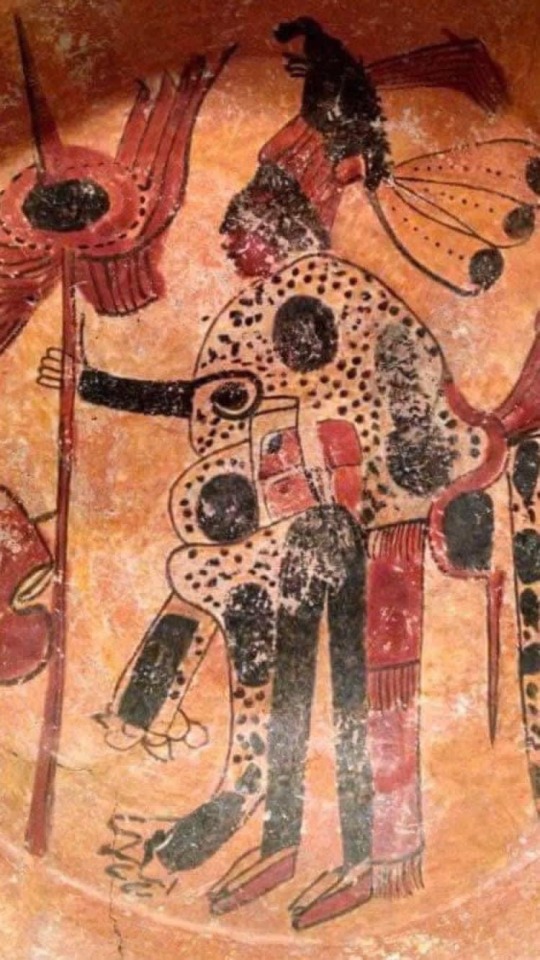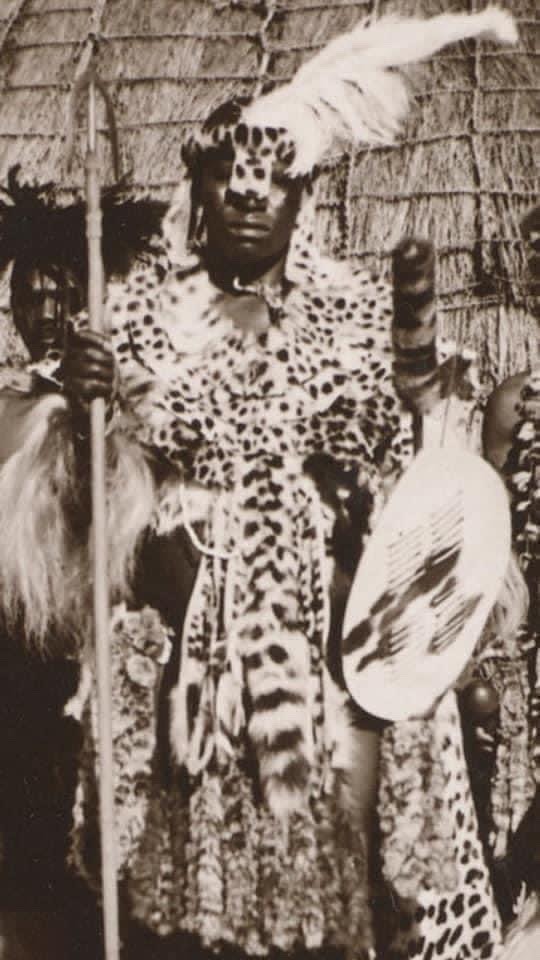#Marquez 1920
Photo
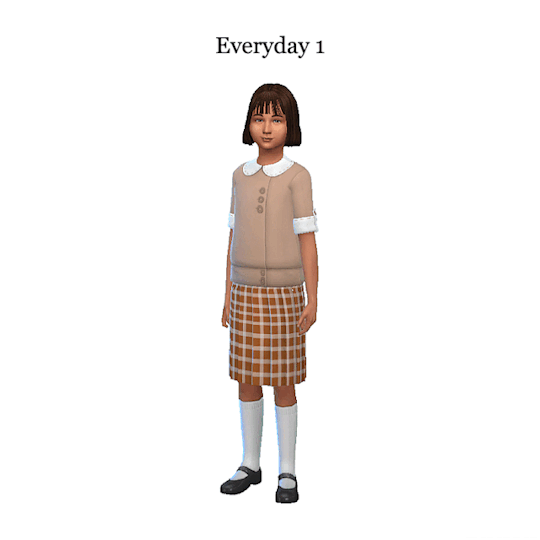

Luisa Huntington: 1920s Lookbook
An early-to-mid-1920s children’s lookbook for Luisa Grace Huntington, the eldest child of Olga Cortes and J Huntington III. Luisa comes from a privileged background as the daughter of a politician, but her parents are trying to give her a normal upbringing. She plays the violin and enjoys school. Luisa has the Cheerful trait.
everyday 1: hair / dress
everyday 2: outfit
formal: dress
athletic: outfit
sleepwear: nightgown
party: bow / dress / shoes
going out: hat / dress
swimwear: swimsuit (TSR)
hot weather: hat / dress
cold weather: coat
Thanks to: @nekochan-simmer, @twentiethcenturysims, @historicalfictionsims, @pixelnrd, @peebsplays, @sisselin, @zurkdesign, + @historicalsimslife
#1920s lookbook#ts4 historical#ts4 decades challenge#historical lookbook#ts4 1920s#child lookbook#1920s sims#Marquez 1920#Marquez gen4#Marquez lookbook#Luisa Huntington#1920s#random decades challenge
156 notes
·
View notes
Text
spring summer 2024 tbr list 🫶🏻
currently reading agnes grey by anne brontë by listening to the audiobook while doing all my drawing for class 🙏🏻 spotify classics audiobooks save me
white noise by don delillo (my bf is going to read libra next so we r going to do don delillo buddy read)
love in the time of cholera by gabriel garcia marquez bc i read 100 years of solitude last summer & loved…
the iliad by homer tr emily wilson bc i loved her translation of the odyssey when i read it in 2022 but don’t think i will have the mental energy for it until i finish the semester 🙏🏻
sense & sensibility bc i’m on my jane austen grind lately (just read emma for the first time & re-read pride and prejudice in the last two weeks lol)
lady chatterly’s lover by d.h lawrence bc i’m interested to see what 1920’s smut is like
shuggie bain by douglas stuart because i borrowed it from the camp library last summer & i need to return it when camp opens in june…
#i may drop some of these of course bc i’m such a mood reader & i’ll read other things too but these are just the books on my mind…#also interested in house of leaves….
17 notes
·
View notes
Text
Compare and contrast The Mechanical Head (The Spirit of Our Time) by Raoul Hausmann to Cadillac Ranch by Chip Lord, Hudson Marquez, and Doug Michels - An 'Isms' Overview
Artworks often serve as reflections of the social and cultural contexts in which they are created. Raoul Hausmann‘s “The Mechanical Head (The Spirit of Our Time)” (1920) and Chip Lord, Hudson Marquez, and Doug Michels‘ “Cadillac Ranch” (1974) are two significant pieces of art that emerged from different periods of history. This comparative analysis aims to explore the similarities and differences…

View On WordPress
0 notes
Text
Philippine Literature in English
In a way, we can say that we can trace the beginnings of Philippine literature in English with the coming of the Americans. For this purpose, we can divide this period into three time frames, namely:
1. The Period of Re-orientation: 1898-1910
2. The Period of Imitation: 1910-1925
3. The Period of Self-Discovery: 1925-1941
(1) The Period of Re-orientation (1898-1910)
English as a literary vehicle came with the American occupation in August 13, 1898 and as they say, a choice bestowed on us by history. By 1900, English came to be used as a medium of instruction in the public schools. From the American forces were recruited the first teachers of English. By 1908, the primary and intermediate grades were using English. It was also about this time when UP, the forerunner in the use of English in higher education, was founded.
Writers of this period were still adjusting to the new found freedom after the paralyzing effect of repression of thought and speech under the Spanish regime. They were adjusting the idea of democracy, to the new phraseology of the English language and to the standards of the English literary style Writers had to learn direct expression as conditioned by direct thinking. They had to learn that sentence constructions; sounds and speech in English were not the same as in the vernacular. They had to discard sentimentality and floridity of language for the more direct and precise English language.
Not much was produced during this period and what literature was produced was not much of literary worth. The first attempts in English were in two periodicals of this time:
(a) El Renacimiento: founded in Manila by Rafael Palma in 1901.
(b) Philippines Free Press : established in Manila in 1905 by R. McCullough Dick and D. Theo Rogers. POETRY In 1907, Justo Juliano’s SURSUM CORDA which appeared in the Renacimiento was the first work to be published in English.

In 1909, Jan F. Salazar’s MY MOTHER and his AIR CASTLES were also published in this paper. It was also in 1909 when Proceso Sebastian followed with his poem TO MY LADY IN LAOAG, also in this same paper.
(2) The Period of Imitation (1910-1924)
By 1919, the UP College Folio published the literary compositions of the first Filipino writers in English. They were the pioneers in short story writing.
They were then groping their way into imitating American and British models which resulted in a stilted, artificial and unnatural style, lacking vitality and spontaneity. Their models included Longfellow and Hawthorne, Emerson and Thoreau, Wordsworth and Tennyson, Thackeray and Macaulay, Longfellow, Allan Poe, Irving and other American writers of the Romantic School. Writers of this folio included Fernando Maramag (the best editorial writer of this period) Juan F. Salazar, Jose M. Hernandez, Vicente del Fierro, and Francisco M. Africa and Victoriano Yamzon. They pioneered in English poetry. ESSAYS The noted essayists of this time were: Carlos P. Romulo, Jorge C. Bocobo, Mauro Mendez, and Vicente Hilario. Their essays were truly scholarly characterized by sobriety, substance and structure. They excelled in the serious essay, especially the editorial type.
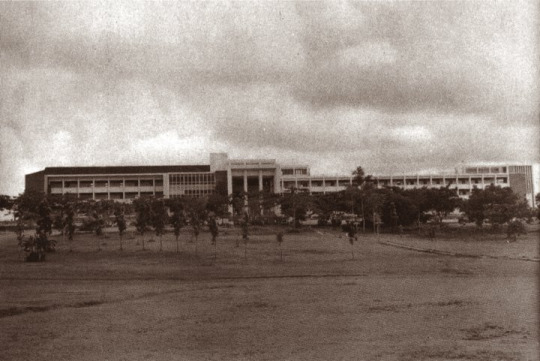
The next group of writers introduced the informal essay, criticism and the journalistic column. They spiced their work with humor, wit and satire. These group included Ignacio Manlapaz, Godefredo Rivera, Federico Mangahas, Francisco B. Icasiano, Salvador P. Lopez, Jose Lansang and Amando G. Dayrit. SHORT STORIES In the field of short stories, DEAD STARS by Paz Marquez Benitez written in the early 1920’s stand out as a model of perfection in character delineation, local color, plot and message. Other short stories published during this time were but poor imitations of their foreign models.
The UP College Folio was later replaced by the Philippine Collegian. Newspapers and periodicals also saw print during this time like the Bulletin, the Philippines Herald (1920), the Philippine Review, the Independent, Rising Philippines and Citizens, and the Philippine Education Magazine 1924. D. Period of Self-Discovery and Growth (1925-1941) By this time, Filipino writers had acquired the mastery of English writing. They now confidently and competently wrote on a lot of subjects although the old-time favorites of love and youth persisted. They went into all forms of writing like the novel and the drama
1. POETRY
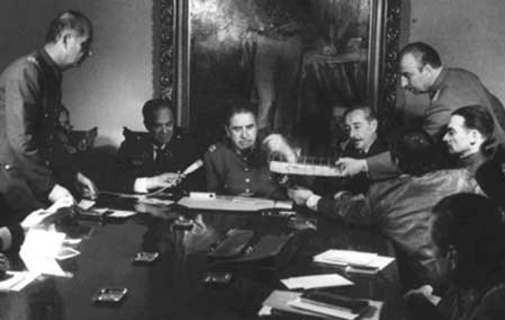
Noteworthy names in this field include Marcelo de Gracia Concepcion, Jose Garcia Villa, Angela Manalang Gloria, Abelardo Subido, Trinidad Tarrosa Subido and Rafael Zulueta da Costa. They turned our not only love poems but patriotic, religious, descriptive and reflective poems as well. They wrote in free verse, in odes and sonnets and in other types. Poetry was original, spontaneous, competently written and later, incorporated social consciousness.
2. THE SHORT STORY (1925-1941)
Probably because of the incentives provided by publications like the Philippine Free Press, The Graphic, The Philippine Magazine and college publications like the UP Literary Apprentice, poetry and the short story flourished during these times.
Other writers during this time include Osmundo Sta. Romana, Arturo Rotor, Paz Latorena’s Sunset, and Jose Garcia Villa’s Mir-in-isa. From 1930 to 1940, the Golden Era of Filipino writing in English saw the short story writers “who have arrived,” like Jose Lansang’s The Broken Parasol, Sinai C. Hamada’s Talanata’s Wife, Fausto Dugenio’s Wanderlust, Amando G. Dayrit’s His Gift and Yesterday, Amador T. Daugio’s The Woman Who Looked Out of the Window. Characteristics of the short stories during these times: There were still remnants of Spanish influence in the use of expressions that were florid, sentimental, exaggerated and bombastic. The influence of the Western culture also was already evident

3. ESSAYS AND OTHER PROSE STYLES (1925-1941)
Essays during this period improved with the years in quality and quantity, in content, subject and style. Essayists like Carlos P. Romulo
became even more eminent editorial writers. The notable writers of essays during this period were: a. Political, social reflective essays:
Through their newspaper columns the following became very popular: Federico Mangahas, Salvador P. Lopez, Pura S. Castrence, Vicente Albano Pacis, Ariston Estrada and Jose A. Lansang. b. Critical essays
were espoused by Salvador P. Lopez, I.V. Mallari, Ignacio Manlapaz, Jose Garcia Villa, Arturo B. Rotor, and Leopoldo Y. Yabes. An example of this is Maximo V. Soliven’s THEY CALLED IT BROTHERHOOD Personal or Familiar essays
were written by F.B. Icasiano (Mang Kiko), Alfredo E. Litiatco, Solomon V. Arnaldo, Amando G. Dayrit and Consuelo Gar (Catuca).
Some of the notable works during this time were: 1940:
Salvador P. Lopez’ LITERATURE AND SOCIETY which is a collection of critical reflections and serious essays and which won first prize in the Commonwealth Literary Contest of 1940.
1940: Camilo Osias published THE FILIPINO WAY OF LIFE, a series of essays on the Filipino way of life as drawn from history, folkways, philosophy and psychology of the Philippines.
1941:
F.B. Icasiano (Mang Kiko) was reprints of the best of Icasiano’s essays in the Sunday Times Magazine under the column From My Nipa Hut. It is an essay of the common “tao” and is written with humor and sympathy. August 16, 1941: Carlos P. Romulo had an editorial printed in the Philippines Herald . Entitled I AM A FILIPINO, it was reprinted in his book MY BORTHER AMERICANS in 1945 in New York by Doubleday & Co. OTHER ESSAYISTS INCLUDE: Ignacio Manlapaz, Vicente Albano Pacis, I.V. Mallari, Jose M. Fernandez, Leopoldo Y. Yabes, Isidro L. Ritizos, Pura Santillan
The Philippine Writer’s League put out a collection of essays called Literature Under the Commonwealth. Amando G. Dayrit with his column Good Morning Judge led others like Leon Ma. Guerrero, Salvador P. Lopez, Vicente Albano Pacis, Jose A. Lansang and Federico Mangahas.
4. BIOGRAPHY 1925-1941 In 1935
I.P. Caballero and Marcelo de Gracia Concepcion wrote about QUEZON. In 1938, THE GREAT MALAYAN won a prize in the national contest sponsored by the Commonwealth of the Philippines. This was written by Carlos Quirino, the most famous biographer of the period. He also wrote Quezon, the Man of Destiny
In 1940, I.V. Mallari’s The Birth of Discontent revealed the sensitive touch of a writer who in simple language was able to reveal his profound thoughts and feelings.
5. HISTORY
Not much about history has been written by Filipino writers. In 1937, with regard to literary history, we can cite Teofilo del Castillo’s The Brief History of the Philippine Islands.
6. PUBLICATIONS
The Philippine Free Press provided the first incentives to Filipino writers in English by offering prizes to worthwhile contributions. Other publications followed suit.
7. THE DRAMA (1925-1941)
Drama during this period did not reach the heights attained by the novel or the short story. The UP provided the incentives when they introduced playwriting as a course and established the UP Little Theater
0 notes
Text
Philippine Literature in English

Salvador Lopez was a well-known writer, journalist, and politician from the Philippines. In San Felipe Neri, Naujan, Oriental Mindoro, the Philippines, on May 27, 1911, he was born. He studied while working his way through school and grew up in a farming family. After enrolling at the University of the Philippines, Lopez graduated with a philosophy degree in 1933 and a law degree in 1939. He actively participated in political and social movements as a student to free the Philippines from American colonial rule. Lopez pursued a career in journalism after receiving his degree, working for publications such as the Manila Tribune, Philippine National News Service, and Philippine Commonwealth Review. His writings centered on social and political issues, such as the plight of the workers, farmers, and marginalized groups in the Philippines.
Books: Literature and society
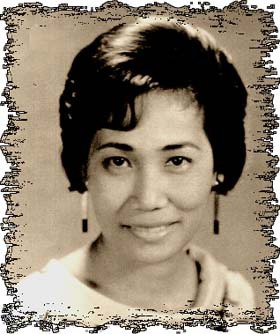
Marquez-Benitez was born in Lucena City, Quezon, Philippines, into a family of educators and intellectuals. She attended the University of the Philippines, where she was among the first female students to enrol in the college's newly created liberal arts program. After completing her undergraduate studies in 1915, she went on to Columbia University in New York to complete her graduate work.
In the 1920s, Marquez-Benitez started penning short stories at a time when male authors predominated in the Philippine literary scene. Her most well-known piece, "Dead Stars," which was published in 1925's Philippine Herald, is regarded as the country's first contemporary short story. Unrequited love missed opportunities, and youth disillusionment is themes that are addressed in the story.
The short story Dead Stars (1925), in which the two main characters are presented as allegories to American imperialism in order to portray the gradual deterioration of Philippine heritage, is the work for which she is best known. A Night in the Hills (1925) is the only other known publication of her writing.
0 notes
Text
POST-EDSA 1 REVOLUTION: 2 REMARKABLE FILIPINO WRITERS

Nicomedes Marquez Joaquin
Short biography:
Nick Joaquín was a Filipino writer born in 1917 to a prosperous and deeply Catholic family in Manila. Although his father was once a popular lawyer, their family fortune was lost in the 1920s. Nick dropped out of school and later worked at the Tribune publishing company. He gained recognition after World War II with the publication of his signature stories like "Summer Solstice" and "May Day Eve." He was also a public figure in Philippine letters and joined the Philippine Free Press in 1950. His notable works include the novel The Woman Who Had Two Navels and the play A Portrait of the Artist as Filipino. Nick Joaquín was conferred the rank and title of National Artist of the Philippines for Literature and considered one of the most important Filipino writers.
Contribution:
Nick Joaquín's contribution to Philippine literature includes his writings on the Spanish colonial period, exploration of the Filipino heritage, and the intricacies of human nature. He was honored as a national artist for literature in 1976.
Reference:
Nick Joaquin: The Biography. (n.d.). http://kathangpinoy.blogspot.com/2014/04/nick-joaquin-biography.html?m=1
Photo source: https://en.m.wikipedia.org/wiki/File:Nick_Joaquin_Portrait_from_Fringe.jpg

Carlo Magno Jose Caparas
Short biography:
Carlo Magno Jose Caparas (born December 15, 1948) is a Filipino comic strip creator, writer, film director, and producer. He is well-known for creating popular Filipino superheroes and comic book characters such as Panday, Bakekang, Totoy Bato, Joaquin Bordado, Kamagong, Kamandag, Elias Paniki, Tasya Fantasya, Gagambino, Pieta, and Ang Babaeng Hinugot sa Aking Tadyang. He is also recognized as a director of numerous films, including massacre films like Kuratong Baleleng and The Cory Quirino Kidnap: NBI Files. Caparas has received various awards and recognition for his contributions to Philippine popular culture, and he continues to be a prominent figure in the Philippine entertainment industry.
Contribution:
He is best known for creating such Filipino superheroes and comic book characters as Panday, Bakekang, Totoy Bato, Joaquin Bordado, Kamagong, Kamandag, Elias Paniki, Tasya Fantasya, Gagambino, Pieta and Ang Babaeng Hinugot sa Aking Tadyang, among others.
Reference:
Wikiwand - Carlo J. Caparas. (n.d.). Wikiwand. https://www.wikiwand.com/en/Carlo_Caparas
Photo source: https://mydramalist.com/people/42319-carlo-j-caparas
0 notes
Text
Aujourd'hui, dimanche 12 mars, nous fêtons Sainte Justine.

SAINT DU JOUR
. Justine
. Du latin Justina, nom de femme, de Justus (voir Juste)
. Sainte-Justine-Bezzoli (+1319) Née à Arezzo en Toscane, elle entre à 13 ans chez les bénédictines. Elle vit ensuite comme recluse à Civitella.
. Les Justine sont perpétuelle fantaisie. Infidèles, elles sont pourtant tendres et bonnes. Gracieuses et désarmantes. Elles sont très attirées par les enfants et ce sont des mères chaleureuses et attentives.
. Prénoms dérivés : Juste, Justinien
Nous fêtons également les :
Bodmaël - Bodvaël - Fina - Fine - Finette - Justine - Maximilian - Maximiliane - Maximilienne - Paul-Aurélien - Pol - Pol-Aurélien - Polig - Théophane - Théophanée - Théophania - Théophanie - Théophano - Tifenn - Tiffanie - Tiffany - Tiphaine - Tiphania - Tiphanie - Typhaine - Typhen
Toutes les infos sur les Saints du jour https://tinyurl.com/wkzm328
FETE DU JOUR
Quels sont les fêtes à souhaiter aujourd'hui ? [ Bonne fête ]
. Justine Henin, joueuse de tennis belge.
. Justine Bateman, actrice américaine, sœur de l'acteur Jason Bateman.
. Justine Lévy, femme de lettres française.
. Justine Robbeson, athlète sud-africaine, spécialiste du lancer du javelot et des épreuves combinées.
. Justine Dufour-Lapointe, skieuse acrobatique canadienne
Ils nous ont quittés un 12 mars :
12 mars 2020 : Tonie Marshall, née Anthony-Lee Caroline Julie Marshall, actrice, réalisatrice, scénariste de cinéma et chorégraphe franco-américaine (29 novembre 1951)
12 mars 2009 : Yann Brekilien, écrivain, historien, résistant et magistrat breton (11 décembre 1920)
12 mars 2001 : Robert Ludlum, écrivain américain (25 mai 1927)
12 mars 1999 : Yehudi Menuhin, violoniste, altiste et chef d'orchestre américain (22 avril 1916)
12 mars 1942 : Robert Bosch, industriel allemand, fondateur de Robert Bosch GmbH en 1886 (23 septembre 1861)
Ils sont nés le 12 mars :
12 mars 1987 : Cylia, chanteuse
12 mars 1984 : Jaimie Alexander, née à Greenville en Caroline du Sud, actrice américaine connue dans la série Kyle XY sous le nom de Jessi Hollander (ou Jessi XX)
12 mars 1979 : Pete, né Peter Doherty, musicien britannique
12 mars 1976 : Julien Courbey, acteur français
12 mars 1970 : Marine Delterme, actrice française
12 mars 1968 : Aaron Eckhart, acteur américain
12 mars 1957 : Patrick Battiston, footballeur international français reconverti entraîneur
Toutes les naissances du jour https://tinyurl.com/msmk5e22
Fêtes, Célébrations, événements du jour
12 mars : Journée mondiale contre la censure sur internet (JM)
CITATION DU JOUR
Citation du jour :
La crainte de la guerre est encore pire que la guerre elle-même.
Sénèque.
Citation du jour :
L'amour, c'est prouver à l'autre que les défauts peuvent être des qualités. C'est le sublimer d'un regard, le concrétiser d'une parole, l'invoquer d'une pensée.
Valentin Auwercx
Toutes les citations du jour https://tinyurl.com/payaj4pz
Petite histoire... digne d'un caramel...
P'tite #blague du #dimanche
Le bêtisier des pharmacies : La cliente : Surtout, marquez-moi bien la posologie sur la boîte, car je ne sais pas lire.
P'tite #blague du #dimanche
Une femme audacieuse ne cherche pas à avoir beaucoup d'hommes à ses pieds, seulement un à sa hauteur.
P'tite #blague du #dimanche
Un touriste visite un château en Écosse. Il s'adresse au châtelain :
� On m'a dit que votre château était hanté !
� Hanté mon château ? Y'a jamais eu aucun fantôme ici !
Et pourtant ça fait 300 ans que je vis ici !
Petit clin d'oeil sur le jardin :
C'est peut-être le moment...
De mettre en place des treillages avant de planter des grimpantes.
De planter des actinidias.
Nous sommes le 71ème jour de l'année il reste 294 jours avant le 31 décembre. Semaine 10.
Beau dimanche à tous.
#ephemerides#ephemeride#almanach#citation#citations#citation du jour#bonnefete#fete#fetedujour#saint#saintdujour#saints#saint jour#catholic#calendrier#agenda#mardi#mars#date naissance
0 notes
Text
detailed inventory of the books i got at the friends of the library book sale last friday:
fuzz, by mary roach (2021). it’s mary roach again. 5 years separate this book from her last one (grunt, 2016), the longest she’s ever taken between books since she started putting em out. this one is about wild animals and their relationship with humans (the subtitle is “when nature breaks the law” but it’s much broader than that)
the norton anthology of short fiction, r v cassill, ed. (1st edition, 1978). a fat book- 1400+ dense pages on wispy bible paper. embarrassingly dated in some ways: extremely americentric (and secondarily eurocentric): yukio mishima is the sole author to represent the whole of asia (no lu xun? no tagore?), borges represents all of south america (no garcia marquez?). africa is represented solely by doris lessing, who was hardly representative, and spent most of her life in the uk anyway (where’s achebe?). treats genre fiction in an embarrassing, tokenist way: one holmes story for all of detective fiction, one poe story on the weird/horror front; a story apiece from clarke, bradbury, le guin, and vonnegut for science fiction- and some of them are odd choices too- le guin is represented by the frankly underwhelming “the new atlantis” rather than eg omelas or winter’s king, probably because the new atlantis is less overtly speculative, and the fantastical elements can be read as being allegorical. (later editions are somewhat better, i guess- in particular they’ve swapped in more works by women and black authors- but are still pretty americentric, and still embarrassingly out of touch with genre fiction. they did at least swap in omelas for the new atlantis eventually)
don quixote, by miguel de cervantes (1605, 1615), translated and abridged by walter starkie (1954). starkie did a translation of the whole thing in 1964, but this will do for now.
the house of the seven gables, by nathaniel hawthorne (1851). a very beat-up wal-mart-branded mmp
the turn of the screw and other stories, by henry james (1966). a creaky old mmp with the turn of the screw, the pupil, the tree of knowledge, and the figure in the carpet. has a little biographical sketch, brief notes on the stories, and a critical bibliography, because this was a classier time
spoon river anthology, by edgar lee masters (2nd ed, 1916). i actually already have a copy of spoon river- but it’s a reproduction of the first edition, from 1915. the second edition of 1916 added 35 poems- which i now have (the epilogue is embarrassing).
four signet classic editions of sinclar lewis’s novels: main street (1920), babbitt (1922), arrowsmith (1925), and elmer gantry (1927). the same guy likely owned all these originally (two of them have address stickers in them), and he must’ve gotten them around the same time, though they have design variations indicating they’re from differing print runs. they’re in decent condition. unfortunately, said guy apparently did not have dodsworth (1929), which signet did have out at the time. but this is not surprising, as dodsworth has always sort of been the runt of lewis’s five “major” novels, and by far the least popular, barring the film adaptation. signet actually no longer has dodsworth in print in any form, though they have the four others, and it can’t happen here (1935), in current editions of varying niceness
one hundred years of solitude, by gabriel garcia marquez (1967). of course i got it
and quiet flows the don, by mikhail sholokhov (1928-1940). another important work of world literature
0 notes
Text
St pete little theatre

Simple enough-the Orsino and Olivia households were represented by doors on Productions have been set in the Caribbean in the last decade, but the locale’sįamiliarity to its Floridian audience made it particularly appropriate. This transplantation is not unique, as a few Placed Illyria somewhere among the present-day islands, even including casual Of rum and lime set to the tunes of a Caribbean beat.” Director John Conlon Accordingly, its Twelfth Night was unusual in both (true community theatre!), and their repertoire focuses primarily on modernĭrama and musicals. The entire organization runs on its volunteers Operating community theatre in Florida, with Twelfth Night concluding Pleasantly surprised the night afforded me a cozy theatre, a delightful play,Īnd as much complimentary wine and coffee as I desired. Parking lot and then the building itself, looking bruised from its rough Little Theatre, I first noticed the interstate barreling next to its back Sir Toby Belch, Trish Perry as Feste, and Holly Weber as Olivia.Įxterior. Sebastian, Melanie Marquez as Viola, Tom Massey as Malvolio, Richard Miller as Robert Colwell as Sir Andrew Aguecheek, William Glenn as Orsino, Joe McCue as ĭirected by John Conlon and musically directed by Latoya "Review of Twelfth Night, presented by the St. “If you’re a musician out there, and you have a great band and you want to be discovered, call us.”įor more information go to Night, presented by the St. “We literally have live music every day of the week, we are only closed on Monday,” said Chadwick. What’s most important for Chadwick, is all the new memories and opportunities that will be made for future musicians and fans alike. When they were asked to be the headliner during the grand reopening earlier this month, it was an honor. The Black Honkeys Band even shot their music video, “Icebreaker,” in the theater back in 2014. “Countless shows, countless smiles, countless good times,” said Esposito. The venue reopening is especially heartfelt for Brother Phil, who grew up going to shows there until he ended up performing himself. “This wall will be in a museum someday,” said Esposito. “We had Jon Bon Jovi, I think Pink has played here, there are so many great acts that started here and moved their way up the ladder,” said Chadwick.īehind the stage there is even a wall, autographed by many of these artists, including hometown singer Brother Philip Esposito, of The Black Honkeys Band. “I wanted to create something that will last the test of time for another 100 years,” said Chadwick.Ĭhadwick also wanted to retain that nostalgic 1920s feel, and pay homage to all the performers that played the room over the decades. Over the past two and a half years his team has renovated every aspect of the 97-year-old music venue, which had been closed since 2017. “And she said to me, ‘oh honey that's where your dad and I had our first date,’ and at that point, I didn’t have any choice I had to buy the theater of course,” said Chadwick. When Chadwick first entertained the idea of restoring the State Theater on Central Avenue he admits he was a little uncertain until he spoke with his mom. Pete, there were six initially and they’ve all been torn down except for this one,” said owner Kevin Chadwick. “This is the last remaining of the old theaters in downtown St. The historic State Theater, dating back to 1924, has just reopened under a new name, The Floridian Social Club. However, now they have a chance to sing a different tune. PETE - With concerts continuously being canceled, musicians have had a challenge finding places to play.

0 notes
Photo


Olga Cortes Huntington: 1920s Lookbook
A lookbook for the tail end of the 1920s, just before Black Tuesday, the Wall Street stock market crash that resulted in the Great Depression, for Olga Cortes Huntington, the matriarch of the Huntington family and wife of California state Representative J. Huntington III. I featured Olga in a lookbook at the beginning of the decade, but wanted to have one of her in her middle age. A stay-at-home mother of four, Olga is working to rebuild her relationship with her husband and be a good influence for her children as they enter adulthood.
everyday 1: hair / gray hair acc. / dress / tights (TSR) / shoes
everyday 2: dress
formal: eyeshadow / lipstick / necklace / dress
athletic: top / bloomers
sleepwear: robe & nightgown
underwear: underwear / tights
party: eyeshadow / blush / lipstick / earrings / necklace / dress
going out: hat / coat
swimwear: swimsuit
hot weather: hat / dress
cold weather: hat / coat
Thanks to: @happylifesims (for like, half of Olga’s outfits, let’s be real), @sunnybelloria, @philosimy, @simsfromthepast, @linzlu, @needleworkreve, @chere-indolente, @renorasims, @historicalsimslife, @zeussim, @teanmoon, @waxesnostalgic, + @javitrulovesims
#1920s lookbook#ts4 historical#ts4 decades challenge#historical lookbook#ts4 1920s#1920s sims#Marquez 1920#Marquez lookbook#Marquez gen4#historical sims#Olga Cortes#1920s#random decades challenge
101 notes
·
View notes
Text
Monthly Reading list (March & April)
books
Dubliners by James Joyce
Stolen by Grace Blakeley
Hegel: A Very Short Introduction by Peter Singer
One Hundred Years of Solitude by Gabriel Garcia Marquez
Everyman's Library of Arabic Poetry by Various Authors
Men in the Sun and Other Palestinian Stories by Ghassan Kanafani
Economics and Egalitarianism by Prabath Patnaik
Papers/articles (March/April)
“There Are Reasons for Optimism” Noam Chomsky interviewed by John Nichols for Catalyst; (Link)
The Communist International and The Contributions of Georg Lukacs in the 1920s by Karoly Kokai
THE BLACK SCHOLAR INTERVIEWS: WALTER RODNEY by The Black Scholar
Indian Maoism's dead end by Anish Vanaik
Blind and Dumb Criticism by Roland Barthes (link)
Self- interested Anti- Imperialism by Roderic Day (link)
The Development of Underdevelopment by Andre Gunder Frank (Thanks @apricitystudies for sending me this bestie 😌✨)
Sex Worker Resistance in the Neoliberal Creative City: An auto/ethnography by Alex Tigchelaar (link)
Microplastics found in human blood for first time by Damian Carrington (@godzilla-studies thanks for sending this one bestie 😌✨) (link)
Cuba After the Revolutionaries by Antoni Kapcia
#studying with k#studyingwithk#books#studyblr#academia#reading#studying#dark academia#study aesthetic#desi dark academia#readingrecs#reading recs#mymonthlyreads#clown college#monthly reading#reading list#study#Spotify
14 notes
·
View notes
Text
In the opening scene of Gabriel Garcia Marquez’ [...] One Hundred Years of Solitude, a mysterious foreigner introduces the residents of a sultry and long-isolated town to the wonders of ice, foreshadowing the region’s integration into global networks of technology and trade. Garcia Marquez’ fiction resembles the techno-origin story of Colombia’s first steam-powered sugar mill, wherein a Russian emigrant by way of San Francisco orchestrated a monumental effort to import Scottish machinery to the Cauca Valley for the milling of cane. Shipped to the Pacific port of Buenaventura, the machinery and equipment then survived an arduous transport by ox and mule through jungles and over mountains en route to the fertile plain along the eastern bank of the Cauca River. The packers had to rebuild roads and fortify bridges to handle the heavy industrial load as they inched across the landscape. The entire haul took two and a half years at enormous cost. With the machinery finally installed on the property of the Manuelita estate,
Don Santiago Eder launched the first industrial production of refined white sugar in Colombia on the “first day of the first month of the first year of the twentieth century.”
Such deeds, mythologized and heroic in their retelling, earned Santiago Eder respect as “the founder” and his sons as “pioneers” in the industrialization of provincial Colombia. Their enterprise, Manuelita, S.A., remained the country’s largest sugar operation for much of the twentieth century.
In 1967, [...] Thompson described the evolution and internalization of disciplined concepts of time as intimately tied to the rise of wage labor in industrializing England. His famous treatise on time serves as a reminder that the rise of industrial agriculture affected a reorganization of cultural and social conceptions of time. [...] As the Manuelita steam-powered machines turned on on the “first day of the first month of the first year of the twentieth century,” the company foretold a self-conscious narrative about the rise of industrial agriculture and modernity in Colombia - a self-representation which contrasts with that of other agricultural endeavors that overlapped in time and in space. [...]
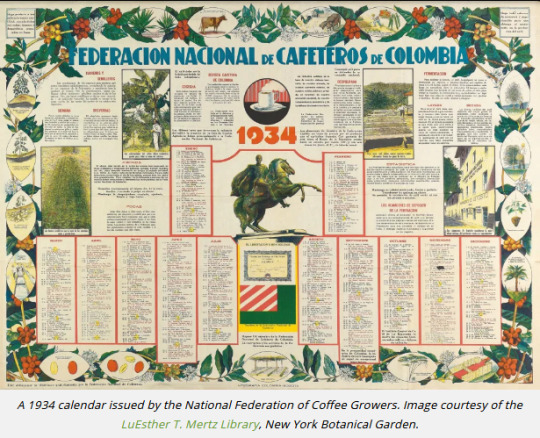
Instructional time [...]
The large size of the calendar issued by the National Federation of Coffee Growers in 1934 suggests its functionality as a wall piece in the homes of middle class cultivators in the country’s mid-altitude coffee axis. [...] This calendar reflects broader trends in Colombian agriculture in the late 1920s and early 1930s, a period of active efforts of state formation in the Colombian countryside. In the late 1920s, the Colombian national state negotiated with departmental governments to create three new agricultural experiment stations. The National Federation of Coffee Growers, as the country’s most important guild and political lobbying organization, took active part in these efforts, and participated in the distribution of seedlings and extension literature. In the calendar, the Federation is patriarchal, instructing the viewer in its cultural and political significance to Colombian identity and prosperity. [...]

Authoritative time [...]
Colombia’s mid-altitude foothills are deeply associated with coffee production in Colombia’s cultural, social, and political imaginary. Likewise, there remains a tendency in Colombia to associate the Cauca Valley lowlands with sugarcane and to assume that this relationship has existed since time immemorial. Such assumptions overlook a much more recent history.
Unlike plantation sugar economies in Brazil and the Caribbean, the industrial production of sugar in Colombia is a twentieth-century phenomenon. Although the Spanish brought sugarcane to the Cauca Valley in the sixteenth century, it remained a relatively small-scale endeavor in the region until the 1930s. [...] The ensuing entrenchment of state-private collaborations between the Palmira station and corporations such as Manuelita [and] [a] new partnership with the United States Department of Agriculture [...] put the valley’s largest sugar growers in a position to [...] distribute and harvest sugarcane hybrids [...]. The 1940s and 1950s thus became a period of disproportionate growth in the refined white sugar sector [...]. The January 1951 image [from the calendar] is especially suggestive of this narrative of confidence and stability. [...] [T]here is a diverse range of people on display, from the company executive at center with sport coat, tie, and sunglasses to Afro-Colombian cane cutters brandishing machetes and other tools. [...] These juxtapositions emphasize both hierarchy and harmony: a modern, smart corporate entity with an educated managerial class and hard-working laborers but also a benevolent corporation seemingly free of labor conflict and unrest. It is a sign of assurance to potential investors in New York City [...]. It is also a moment of (perhaps mandated) convivencia amidst a tumultuous and violent Colombian countryside mere years before major labor strikes gripped the valley’s sugarcane sector.
---
The contrasts evident in these calendars reflect different industries in adjacent regions less than two decades apart, but they also offer contrasting narratives of agricultural futures. Both calendars are patriarchal in the omnipotent ways they depict time and agriculture. [...] Together, these calendars remind us of the Plantationocene as process, one changing over time and following different paths in distinct places or for particular crops. Both discipline the viewer’s internalization of time.
The global ascendency of the Manuelita model of work contracts and monoculture in the second half of the twentieth century underscores the acceleration of the Plantationocene, but the historical presence and persistence of alternative agricultural time should serve as a reminder that [...] futures and the demarcation of epochs are never as simple as a neatly organized calendar.
---
All text above by: Timothy Lorek. “Keeping Time with Colombian Plantation Calendars.” Edge Effects. April 2020. [Images and captions shown as they appear originally published in Lorek’s article. Bold emphasis and some paragraph breaks/contractions added by me.]
103 notes
·
View notes
Text
American Regime

Salvador Lopez was a well-known writer, journalist, and politician from the Philippines. In San Felipe Neri, Naujan, Oriental Mindoro, the Philippines, on May 27, 1911, he was born. He studied while working his way through school and grew up in a farming family. After enrolling at the University of the Philippines, Lopez graduated with a philosophy degree in 1933 and a law degree in 1939. He actively participated in political and social movements as a student to free the Philippines from American colonial rule. Lopez pursued a career in journalism after receiving his degree, working for publications such as the Manila Tribune, Philippine National News Service, and Philippine Commonwealth Review. His writings centered on social and political issues, such as the plight of the workers, farmers, and marginalized groups in the Philippines.
Books:
Literature and society

Marquez-Benitez was born in Lucena City, Quezon, Philippines, into a family of educators and intellectuals. She attended the University of the Philippines, where she was among the first female students to enrol in the college's newly created liberal arts program. After completing her undergraduate studies in 1915, she went on to Columbia University in New York to complete her graduate work.
In the 1920s, Marquez-Benitez started penning short stories at a time when male authors predominated in the Philippine literary scene. Her most well-known piece, "Dead Stars," which was published in 1925's Philippine Herald, is regarded as the country's first contemporary short story. Unrequited love missed opportunities, and youth disillusionment is themes that are addressed in the story.
The short story Dead Stars (1925), in which the two main characters are presented as allegories to American imperialism in order to portray the gradual deterioration of Philippine heritage, is the work for which she is best known. A Night in the Hills (1925) is the only other known publication of her writing.
0 notes
Text
Beatles Theme - Get to Know Me
I was tagged by @thelexidylan : thank you, it’s a very hard and sad time for me, so thank you again
well
1 Name: Paola
Birthday : May, 22
Zodiac sign: gemini
Height: 164 cm
Hobbies: to play guitar, to sing, to make ball jointed dolls, listening music, to learn history
Fav. colour/s: yellow..of course
Inspiration: beatles, 60s, 50s rock n’roll, belle epoque ( 1910-1920) russian ballett, vaslav nijinsky, all silent cinema divas, jazz, ragtime, new orleans jazz, women rights, art nouveau, art
Last song I listened to: The house of the rising sun by the Animals (1964)
Last film I watched: Changeling
Currently reading: gabriel garcia marquez (opera omnia)
Meaning URL : nowherelady, paolainyellowsubmarine
Fav Beatles’ film: A hard day’s night ( in this moment)
Fav Beatles’ album: Revolver
Random Beatles fact: I love what freda kelly said about them at the time and I love her
Random Beatles gif: so perfect

now now now.. I want to tag:
@bangbangmadam
@macca-bby
@longforyesterday
@iamthenowhereman
thank you for your time. kisses . p
23 notes
·
View notes
Text
Xingxiulong chengi

By Ripley Cook
Etymology: Dragon from the Xingxiu Bridge
First Described By: Wang et al., 2017
Classification: Dinosauromorpha, Dinosauriformes, Dracohors, Dinosauria, Saurischia, Eusaurischia, Sauropodomorpha, Bagualosauria, Plateosauria, Massopoda, Sauropodiformes
Status: Extinct
Time and Place: Between 201.3 and 199.3 million years ago, in the Hettangian of the Early Jurassic


Xingxiulong is known from the Shawan Member of the Lufeng Formation

Physical Description: Xingxiulong was a medium-sized prosauropod, about four to five meters long with a height of one to one and a half meters at the hip. It had a smooth jaw, unlike other prosauropods of the time and place, and it had a long jaw like Lufengosaurus. It’s skull was somewhat short, much like that of the later Camarasaurus, and it would have relied more on its neck and hands to grab food rather than a longer snout. This broad snout would have also made it a generalist, rather than specialist, browser. It’s neck was fairly long and muscular, like in other Sauropodomorphs; it also had a long tail.
Xingxiulong was a fairly bulky and heavyset prosauropod, indicating the journey of this line of dinosaurs as it evolved into Sauropods (though of course, Sauropods were already around at this point in dinosaurian evolution). It even had more vertebrae at the hip, like sauropods, and unlike other prosauropods of its time and place. It also had a longer hip bone than prosauropods - once again, one more like the later sauropods. It’s legs were also very robust, like those of the sauropods. Xingxiulong had a very large gut, allowing it to store more food while digesting. This probably is correlated with its increased ability to hold up a large body weight, compared to its contemporaries. In short, Xingxiulong is a prime example of the slow, step-wise evolution of the prosauropods towards the large nature of the Sauropods - though,of course, Xingxiulong is just an offshoot of that line.
Being somewhat larger, Xingxiulong probably was more scaly than not, though it still may have possessed feathers. It probably would have stille mostly walked on just its hindlimbs, though it may have been able to walk on its forelimbs when need be. It still would have mainly used its forelimbs in feeding, more than in locomotion.

By José Carlos Cortés
Diet: Xingxiulong would have been a mid-level browser, feeding on a variety of fairly dry vegetation by reaching up with its arms and long neck.
Behavior: Xingxiulong, unfortunately, doesn’t have a very well-known behavior, though it probably would have spent most of its time browsing in its environment. It would have had to walk around its environment carefully, given how bulky it was and its large mass; it probably wouldn’t have been the fastest of dinosaurs. As a prosauropod, it most likely was active in its metabolism, and it probably took care of its young. It’s also entirely likely that Xingxiulong would forage in its environment in mixed-species herds, with all the other prosauropods of the time and place in which it lived.
Ecosystem: Xingxiulong lived in the Shawan environment of the Lufeng Formation, one of a few classic environments showing off the initial explosion of dinosaur evolution after the end-Triassic extinction. This was a lush environment, with many lakes, rivers, and overbanks. As such, it would have been a very lush and green environment, though no plant fossils have been reported. Here there were many other kinds of animals, especially transitional dinosaurs. In many ways, it was a counterpart to the South African Elliot Formation, in what it shows about the early evolution of large dinosaurs - though the Elliot was much more arid than the Lufeng.

By Scott Reid
Contemporary with Xingxiulong, there were many other Prosauropods that probably would have all grazed together in the plant line in mixed-species herds. Here, there was Jingshanosaurus, Yunnanosaurus, Lufengosaurus, and Gyposaurus, all in the specific environment from which Xingxiulong is known. There was also theropods like the smaller Panguraptor, and the large Sinosaurus which would have been a major pain for Xingxiulong. The potential Coelurosaur Eshanosaurus was present too, but this is doubtful and honestly it probably was just another prosauropod. Also present was Lukousaurus, which more likely than not is just a crocodilian. No ornithischians are known from the same environment as Xingxiulong, unfortunately.
Other: Xingxiulong, though very sauropod-like, was actually only midway on the sauropod family tree! Many animals, even in its own environment, were just as close to sauropods as Xingxiulong was. Still, Xingxiulong gives us a decent picture of how sauropods evolved at the Triassic-Jurassic transition.
~ By Meig Dickson
Sources under the Cut
Apaldetti, C.; Martinez, R.N.; Pol, D.; Souter, T. (2014). "Redescription of the Skull of Coloradisaurus brevis (Dinosauria, Sauropodomorpha) from the Late Triassic Los Colorados Formation of the Ischigualasto-Villa Union Basin, northwestern Argentina". Journal of Vertebrate Paleontology. 34 (5): 1113–1132.
Barrett, P.M.; Upchurch, P.; Wang, X.-L. (2005). "Cranial Osteology of Lufengosaurus huenei Young (Dinosauria: Prosauropoda) from the Lower Jurassic of Yunnan, People's Republic of China". Journal of Vertebrate Paleontology. 25 (4): 806–822.
Barrett, P.M.; Upchurch, P.; Zhou, X.-D.; Wang, X.-L. (2007). "The skull of Yunnanosaurus huangi Young, 1942 (Dinosauria: Prosauropoda) from the Lower Lufeng Formation (Lower Jurassic) of Yunnan, China". Zoological Journal of the Linnean Society. 150 (2): 319–341.
Lu, J.; Kobayashi, Y.; Li, T.; Zhong, S. (2010). "A New Basal Sauropod Dinosaur from the Lufeng Basin, Yunnan Province, Southwestern China". Acta Geologica Sinica. 84 (6): 1336–1342.
Luo, Z.; Wu, X.-C. (1997). "The small tetrapods of the Lower Lufeng Formation, Yunnan, China". In Fraser, N.C.; Sues, H.-D. (eds.). In the Shadow of the Dinosaurs: Early Mesozoic Tetrapods. Cambridge: Cambridge University Press. pp. 251–270.
Martinez, R.N. (2009). "Adeopapposaurus mognai, gen. et sp. nov. (Dinosauria: Sauropodomorpha), with comments on adaptations of basal Sauropodomorpha". Journal of Vertebrate Paleontology. 29 (1): 142–164.
McPhee, B.W.; Yates, A.M.; Choiniere, J.N.; Abdala, F. (2014). "The complete anatomy and phylogenetic relationships of Antetonitrus ingenipes (Sauropodiformes, Dinosauria): implications for the origins of Sauropoda". Zoological Journal of the Linnean Society. 171 (1): 151–205.
McPhee, B.W.; Bonnan, M.F.; Yates, A.M.; Neveling, J.; Choiniere, J.N. (2015). "A new basal sauropod from the pre-Toarcian Jurassic of South Africa: evidence of niche-partitioning at the sauropodomorph–sauropod boundary?". Scientific Reports. 5: 13224.
McPhee, B.W.; Choiniere, J.N.; Yates, A.M.; Viglietti, P.A. (2015). "A second species of Eucnemesaurus Van Hoepen, 1920 (Dinosauria, Sauropodomorpha): new information on the diversity and evolution of the sauropodomorph fauna of South Africa's lower Elliot Formation (latest Triassic)". Journal of Vertebrate Paleontology. 35 (5): e980504.
Otero, A.; Pol, D. (2013). "Postcranial Anatomy and Phylogenetic Relationships of Mussaurus patagonicus (Dinosauria, Sauropodomorpha)". Journal of Vertebrate Paleontology. 33 (5): 1138–1168.
Pol, D.; Garrido, A.; Cerda, I.A. (2011). "A New Sauropodomorph Dinosaur from the Early Jurassic of Patagonia and the Origin and Evolution of the Sauropod-type Sacrum". PLoS ONE. 6 (1): e14572.
Prieto-Marquez, A.; Norell, M. (2011). "Redescription of a nearly complete skull of Plateosaurus (Dinosauria, Sauropodomorpha) from the late Triassic of Trossingen (Germany)". American Museum Novitates. 3727: 1–58.
Sues, H.-D.; Reisz, R.R.; Hinic, S.; Raath, M.A. (2004). "On the skull of Massospondylus carinatus Owen, 1854 (Dinosauria: Sauropodomorpha) from the Elliot and Clarens formations (Lower Jurassic) of South Africa". Annals of Carnegie Museum. 73 (4): 239–257.
Wang, Y.-M.; You, H.-L.; Wang, T. (2017). "A new basal sauropodiform dinosaur from the Lower Jurassic of Yunnan Province, China". Scientific Reports. 73: 41881.
Wu, X.-C.; Currie, P.J.; Dong, Z.; Pan, S.; Wang, T. (2009). "A New Theropod Dinosaur from the Middle Jurassic of Lufeng, Yunnan, China". Acta Geologica Sinica. 83 (1): 9–24.
Xing, L.; Rothschild, B.M.; Ran, H.; Miyashita, T.; Persons, W.S.; Sekiya, T.; Zhang, J.; Wang, T.; Dong, Z. (2015). "Vertebral fusion in two Early Jurassic sauropodomorph dinosaurs from the Lufeng Formation of Yunnan, China". Acta Palaeontologica Polonica. 60 (3): 643–649.
Xu, X.; Zhao, X.; Clark, J.M. (2001). "A New Therizinosaur from the Lower Jurassic Lower Lufeng Formation of Yunnan, China". Journal of Vertebrate Paleontology. 21 (3): 477–483.
Yates, A.M.; Bonnan, M.F.; Neveling, J.; Chinsamy, A.; Blackbeard, M.G. (2009). "A new transitional sauropodomorph dinosaur from the Early Jurassic of South Africa and the evolution of sauropod feeding and quadrupedalism". Proceedings of the Royal Society B: Biological Sciences. 277 (1682): 787–794.
#Xingxiulong chengi#Xingxiulong#sauropodomorph#prosauropod#Dinosaur#Dinosaurs#Terrestrial Tuesday#Herbivore#Eurasia#Jurassic#Prehistoric Life#Prehistory#Paleontology#Palaeoblr#Factfile#biology#a dinosaur a day#a-dinosaur-a-day#dinosaur of the day#dinosaur-of-the-day#science#nature
208 notes
·
View notes

